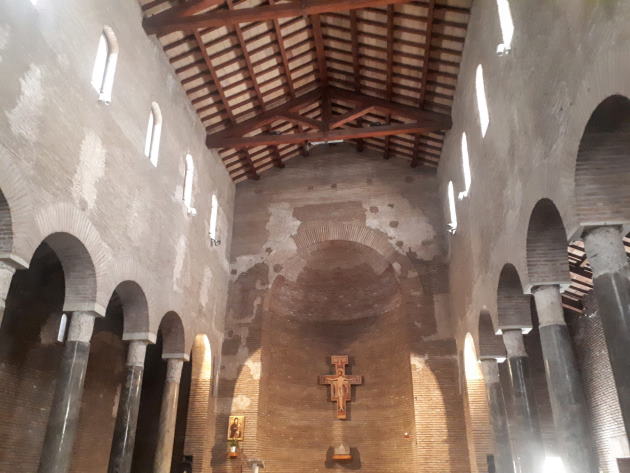
San Lorenzo in Piscibus is a small and suggestive church, hidden and closely constrained by 20th-century buildings, in the Rione Borgo near St Peter’s: if we can still admire it today, it is because it was among the buildings preserved during the demolition of the Spina di Borgo as part of the clearances for the Via della Conciliazione, even though its façade and entrance portico were however destroyed. Today, only its small medieval apse, extensively restored, remains visible along Borgo Santo Spirito.
The church has very ancient origins: its legendary foundation is by St Galla, a noble Roman matron of the 6th century, even if the church is first recorded in 1143. The dedication is to St Lawrence, one of the most famous Roman martyrs, while the appellation “in piscibus” possibly comes from a nearby fish market. During the 16th century, the church was first granted to a convent of Poor Clares, then to a lay confraternity and lastly incorporated into Cardinal Francesco Armellini’s palace. In the second half of the 17th century, the complex was entrusted to the Brothers of the Christian Schools or Piarists who had the church radically restored in Baroque style. In 1733, the Piarists commissioned Domenico Navone to provide a new façade together with a long atrium, which were then destroyed in the 20th century.
In the restorations carried out in the first half of the 20th century, the building was brought back to its presumed original Romanesque lines, canceling subsequent interventions and destroying the Baroque fittings. Deconsecrated and used as a lecture hall for the Scuola Pontificia Pio IX before becoming a studio for the famous sculptor Pericle Fazzini in the 1970’s, the church was re-consecrated in 1983 and made titular for the first time in its history in 2007.
The interior is divided into a nave and side aisles by arcades with eleven ancient marble columns. The walls have all been stripped and are bare brick, and the modern wooden truss roof has no ceiling. The campanile is from the 12th century and sits over the entrance end of the left hand aisle. Despite the extensive renovations, large portions of the original masonry can still be recognized. The excavations carried out under the church have made it possible to discover many Roman remains.
Information
Holy Mass times
Monday: 18.15Tuesday: 18.15Wednesday: 18.15Thursday: 18.15Friday: 18.15Saturday: 18.15Sunday: 18.15
Times are subject to change, so please always contact the church to confirm.
 Condividi
Condividi
Location
To find out about all accessibility services, visit the Rome accessible section.











































